Hard to Digest: A Gastrointestinal Photo Quiz
The types of digestive disorders are many, and the symptoms vary widely. This week's photo quiz offers a variety of presentations to test your diagnostic acumen.
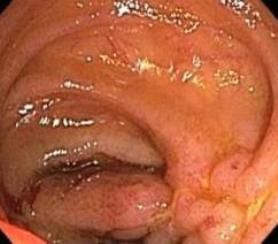
Question 1:
This colonoscopic view of the ileum shows the moderate to severe inflammation typical of Crohn disease. Many patients with Crohn disease or ulcerative colitis have involvement outside of the bowel-extraintestinal “red herrings”-that can obscure the diagnosis of inflammatory bowel disease in the absence of a high index of suspicion.
NEXT QUESTION »
For the discussion, click here.
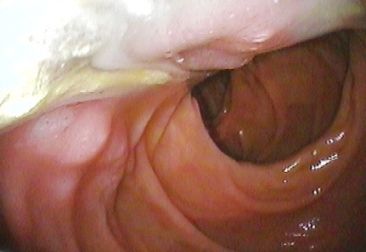
Question 2:
A 61-year-old obese man with newly diagnosed type 2 diabetes mellitus and hypertension complained of fatigue, poor oral intake, and weight loss. A esophagogastroduodenoscopy, shown here, revealed a posterior wall penetrating duodenal ulcer > 2 cm in diameter. CT of the abdomen and MR cholangiopancreatography revealed acute emphysematous pancreatitis with extensive pancreatic necrosis.
NEXT QUESTION »
For the discussion, click here.
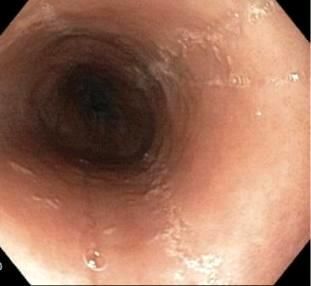
Question 3:
A 25-year-old woman complained of intermittent solid food dysphagia. She was treated 5 years earlier with an 8-week course of lansoprazole. This esophagogastroduodenoscopy shows linear furrowing with trachealization.
In addition to solid food dysphagia, patients may present with abdominal discomfort, chest pain, and nausea.
NEXT QUESTION »
For the discussion, click here.
For the answer, click here.
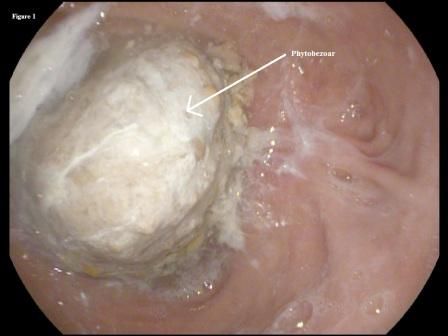
Question 4:
A 59-year-old woman with a history of peptic ulcer disease complained of mild, burning, and nonradiating pain in the epigastrium that worsened with food intake. Upper endoscopy showed a normal gastric remnant, an ulcer at the anastomotic site, and a large bezoar on the gastric side of anastomosis. Biopsy showing vegetable fibers confirmed a diagnosis of phytobezoar.
NEXT QUESTION »
For the discussion, click here.
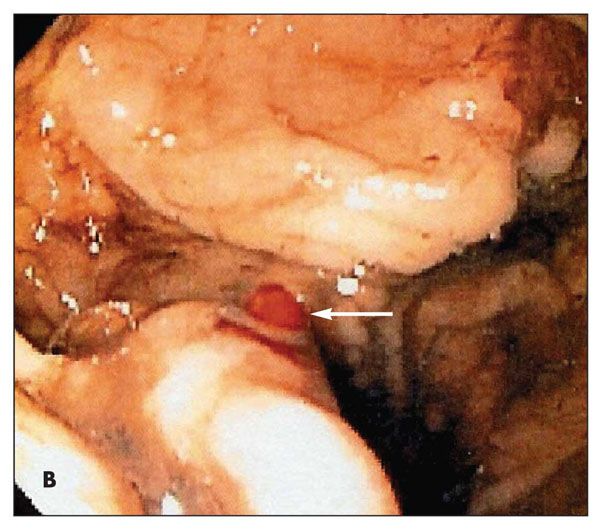
Question 5:
Two days after a 70-year-old man was treated for suspected GI bleeding, he presented with dyspnea, weakness, and lightheadedness. An esophageal ultrasonogram showed a bleeding artery at the proximal fundus. Esophagogastroduodenoscopy revealed a small, red, nipple-like lesion in the proximal stomach (arrow). A histologic section showed a tortuous, thick-walled blood vessel that extended through the gastric submucosa into the overlying luminal epithelium.
NEXT QUESTION »
For the discussion, click here.

Question 6:
Extensive diverticulosis was found throughout the length of the colon of an 84-year-old woman, who depended on a weekly dose of magnesium citrate to have a bowel movement. Typical lesions are shown here.
ANSWER KEY »
For the discussion, click here.
ANSWER KEY:
Question 1. D
Question 2. A
Question 3. B
Question 4. A
Question 5. D
Question 6. B
Clinical Tips for Using Antibiotics and Corticosteroids in IBD
January 5th 2013The goals of therapy for patients with inflammatory bowel disorder include inducing and maintaining a steroid-free remission, preventing and treating the complications of the disease, minimizing treatment toxicity, achieving mucosal healing, and enhancing quality of life.